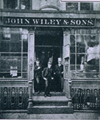- Categories:
Wiley Marks Its Bicentennial With Sponsorship of MetroCards for Hotel ABA Guests
 To celebrate the 200th anniversary of John Wiley & Sons, Inc., as well as Frommer's 50th, and to make travel between Hotel ABA, the New York Marriott at the Brooklyn Bridge, and the Jacob Javits Center that much easier, Wiley will be sponsoring New York City subway MetroCards for all Hotel-ABA registered guests. The cards will be pre-loaded and available to booksellers at the welcome desk at Hotel ABA.
To celebrate the 200th anniversary of John Wiley & Sons, Inc., as well as Frommer's 50th, and to make travel between Hotel ABA, the New York Marriott at the Brooklyn Bridge, and the Jacob Javits Center that much easier, Wiley will be sponsoring New York City subway MetroCards for all Hotel-ABA registered guests. The cards will be pre-loaded and available to booksellers at the welcome desk at Hotel ABA.
"We're excited about the opportunity," said Rob Dyer, Wiley's director of independent accounts. "With both Wiley celebrating its 200th anniversary and Frommer's celebrating its 50th at BEA, we fully appreciate that neither would be possible without the enduring support of our customers. If we can help make it easier for them to conduct business while in New York, we're happy to oblige."
Each MetroCard will be preloaded with six trips (three round trip fares) and will be packaged with another card that includes subway directions to and from the Javits Center. Both will be enclosed in a convenient sleeve that will be designed to commemorate Frommer's 50th anniversary. Hotel ABA is located across the street from a subway stop, and the trip for ABA member booksellers who are staying at other BEA hotels should take only about 15 to 20 minutes by subway. (Watch for detailed instructions to come in the next several weeks.)
 John Wiley |
John Wiley & Sons traces its roots back to 1807, when Charles Wiley opened a print shop in lower Manhattan. He and his son John published such authors as James Fenimore Cooper, Washington Irving, Herman Melville, and Edgar Allen Poet. On May 1, the publisher will celebrate its bicentennial by ringing the closing bell at the New York Stock Exchange, where its shares are traded. Also in May, Wiley will publish an illustrated history book entitled Knowledge for Generations: Wiley and the Global Publishing Industry 1807 - 2007, by Timothy C. Jacobson, George David Smith, and Robert E. Wright. -Karen Schechner

